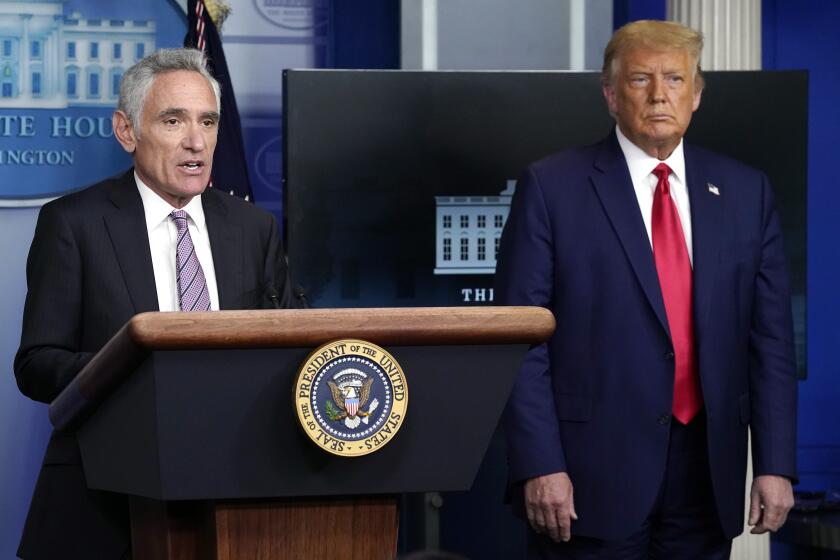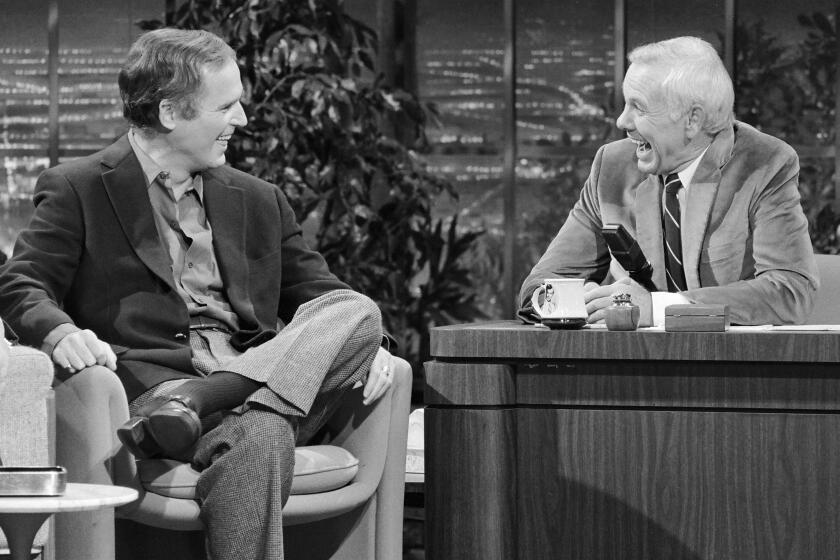Bear Stearns’ former CEO defends practices while saying bank’s ‘leverage was too high’
Former executives at Bear Stearns sought Wednesday to blame the Wall Street firm’s 2008 collapse on an unpreventable “run on the bank” by customers, but an ex-chief executive told lawmakers that the firm had taken on too much risk with excessive borrowing.
Five former leaders of the defunct firm, testifying before a federal commission investigating the causes of the financial crisis, contended that Bear Stearns was not insolvent, or even close to it, when it was acquired in March 2008 by rival JPMorgan Chase & Co.
“I was shocked beyond belief that we failed,” said former Bear Stearns Chief Executive James Cayne.
But under skeptical questioning by the commission, Cayne said the company had taken on too much risk to handle a severe market disruption that it did not see coming.
“In retrospect, in hindsight, I’d say leverage was too high,” Cayne said, using a term for how much a company owes relative to the amount of assets it owns.
Bear Stearns was one of Wall Street’s five major investment banks and the first of three of them that failed or were acquired at fire-sale prices in the market upheaval of 2008.
The company was a major player in the subprime home loan market and bought many of its mortgage-backed securities with money borrowed from other financial institutions, a system that largely escaped the purview of federal regulators.
Such “shadow banking” — which some blame for spreading the effects of the subprime mortgage meltdown throughout the financial system — is the focus of two days of hearings that began Wednesday by the Financial Crisis Inquiry Commission.
JPMorgan acquired Bear Stearns with the help of a $30-billion loan from the Federal Reserve, the first in a series of unprecedented government interventions in the financial system during the crisis.
Cayne, who stepped down as CEO at Bear two months before the firm’s collapse, said its fall “was due to overwhelming market forces” that showed their power six months later with the failure of Lehman Bros., and the bailouts of American International Group and several large banks.
“Considering the severity and unprecedented nature of the turmoil in the market, I do not believe there were any reasonable steps we could have taken, short of selling the firm, to prevent the collapse that ultimately occurred,” he told the commission. He also repeated a theory that has circulated since 2008 that there might have been a conspiracy to take down Bear Stearns — like “a big, fat goose walking down a lane” Cayne said — by hedge funds or other investors who stood to gain from its failure.
Four other former Bear executives said the firm closely monitored its risks, tried to reduce its exposure to the collapsing subprime mortgage market and but didn’t consider itself overextended.
“Fears, rumors and innuendo resulted in irrational behavior that caused the quintessential run on the bank at Bear Stearns,” said Samuel Molinaro Jr., the former chief financial officer and chief operating officer.
Members of the commission didn’t buy the explanation. Commission Chairman Phil Angelides said the assertion that Bear Stearns’ demise was out of the control of its executives sounded like the testimony of executives from other companies that the financial crisis was an “immaculate calamity.” And Commissioner Byron S. Georgiou called the idea that the crisis happened without anybody doing anything wrong was a “pathetic mythology.”
Angelides said Bear Stearns was not only highly leveraged but also heavily dependent on short-term loans, including a large amount of overnight funding. He called such a business model, operating outside the regulated commercial banking system, “a form of financial Russian roulette.”
“You didn’t see, going into turbulent waters, it was necessary to build a higher levee?” Angelides asked Cayne.
Cayne said he did not. He also said greater protection wouldn’t have stopped the rumors that fed the run on the company.
At the time, all five of Wall Street’s top investment banks faced the prospect of mortgage-related losses. The smallest of the five, Bear was the most vulnerable to a loss of market confidence.
Among Wall Street’s big five firms before the crisis, Lehman Bros. went bankrupt, while Bear Stearns and Merrill Lynch were gobbled up by competitors. Goldman Sachs and Morgan Stanley survived but felt compelled to become traditional bank holding companies, giving them access to emergency loans and other federal support.
Also appearing before the panel were two former heads of the Securities and Exchange Commission, Christopher Cox and William Donaldson. The faced criticism from by commission members, who said the SEC failed to provide sufficient oversight of Wall Street firms.
Cox and Donaldson defended their actions, noting the SEC in 2004 created a program that consolidated oversight of the five major investment banks. But the voluntary program lacked broad authority to rein in the firms’ activities.
“I fundamentally agree that the purpose of the program was to provide an early warning system and it didn’t, said Cox, who headed the SEC from mid-2005 until early 2009.
More to Read
Inside the business of entertainment
The Wide Shot brings you news, analysis and insights on everything from streaming wars to production — and what it all means for the future.
You may occasionally receive promotional content from the Los Angeles Times.











